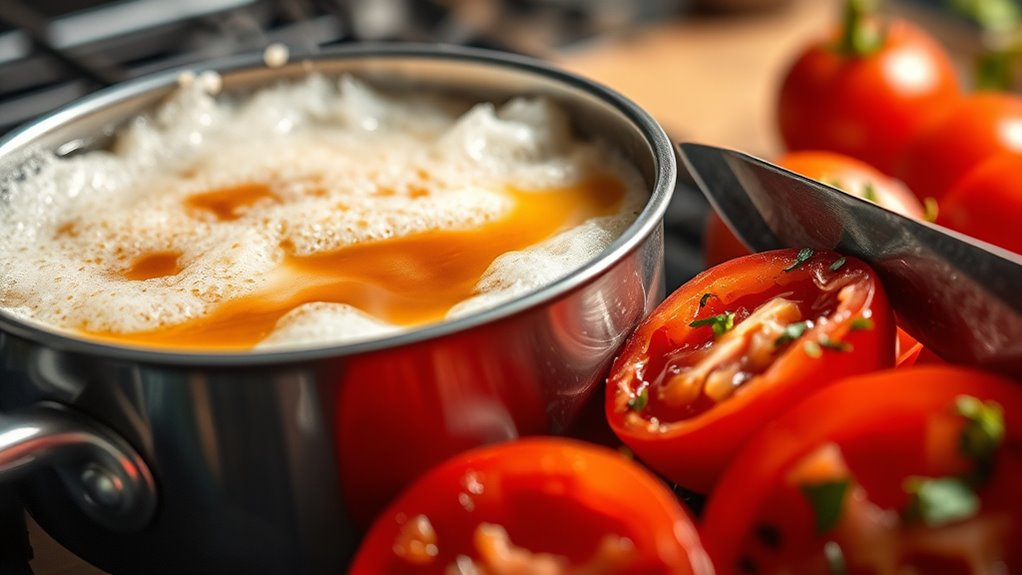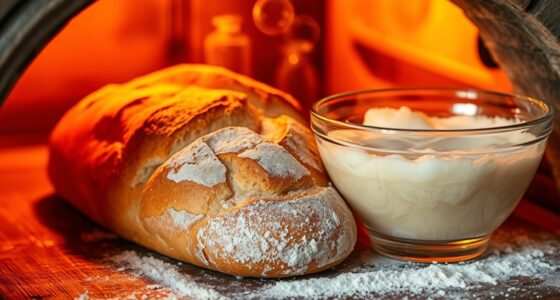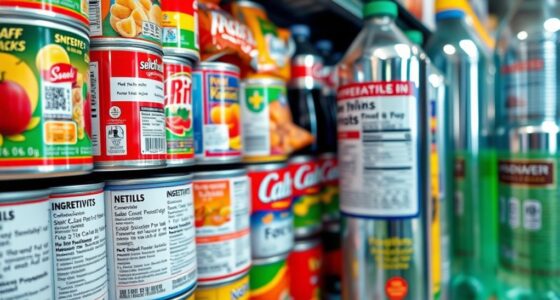In everyday cooking, chemical reactions like the Maillard reaction and caramelization create browning, flavor, and aroma as you sear or roast foods. Leavening agents release gases to make baked goods rise, while proteins denature to improve texture and tenderness. Emulsification stabilizes mixtures like mayonnaise, and fermentation develops flavors and preserves foods through acids and alcohol. Understanding these processes helps you control texture, flavor, and safety—if you want to explore more, keep going.
Key Takeaways
- The Maillard reaction and caramelization produce browning, flavor, and aroma changes during high-temperature cooking.
- Leavening agents like baking soda and yeast generate CO₂, causing dough and batter to rise.
- Heating denatures proteins, altering textures, while enzymes like bromelain tenderize food before cooking.
- Emulsifiers stabilize mixtures like mayonnaise, enabling the blending of oil and water phases.
- Starch gelatinization at specific temperatures creates gels that influence food texture and consistency.
The Science Behind Browning: Maillard Reaction and Caramelization

Browning foods during cooking results from two main chemical reactions: the Maillard reaction and caramelization. The Maillard reaction happens when proteins and sugars react under heat, creating new flavors, aromas, and colors. It’s responsible for the appealing browning of grilled meats, roasted vegetables, and baked bread. This reaction needs high temperatures and the presence of amino acids and reducing sugars. Caramelization, on the other hand, involves heating sugars alone at even higher temperatures, usually above 350°F. It breaks down sugars and reforms them into caramel, producing a sweet, nutty flavor and golden color. While both reactions cause browning, the Maillard involves proteins and sugars at lower temperatures, resulting in complex flavors. Caramelization is purely sugar-based and enhances sweet dishes and desserts with its distinctive taste and appearance.
How Leavening Agents Make Your Baked Goods Rise
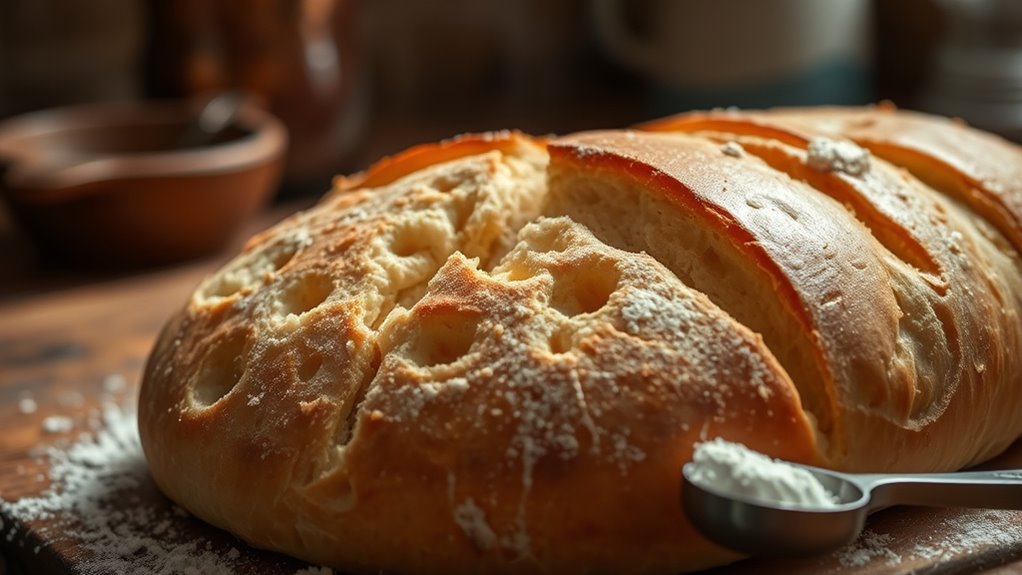
Leavening agents are essential ingredients that help your baked goods rise by producing gases that expand within the dough or batter. Chemical leavening agents like baking soda, baking powder, and ammonium bicarbonate generate carbon dioxide through chemical reactions, causing the mixture to expand. Baking soda reacts with acids such as buttermilk or lemon juice, releasing CO2 quickly. Baking powder contains baking soda and an acid, producing CO2 more gradually. Ammonium bicarbonate releases both CO2 and ammonia gases, mainly used in cookies. Yeast, a biological leavening agent, ferments sugars to produce CO2 and ethanol over time, giving baked goods a different rise process. Heat accelerates these reactions, ensuring your baked items develop the desired volume, texture, and lightness. Understanding leavening processes helps bakers optimize their recipes for perfect results.
The Role of Proteins and Enzymes in Cooking Processes
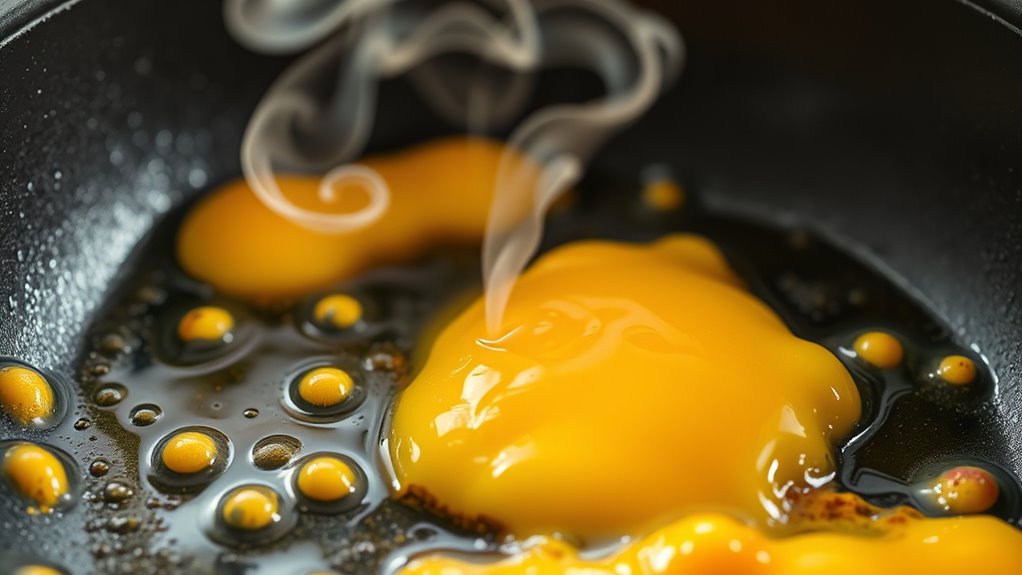
Proteins and enzymes play essential roles in transforming the texture, flavor, and safety of your food during cooking. When heated, proteins denature, unfolding and changing texture—think of eggs coagulating or meat firming. Most animal proteins denature between 40–75°C, losing solubility but gaining binding ability, which improves dough elasticity. Denaturation also exposes amino acids for browning via the Maillard reaction at temperatures above 140°C, creating complex flavors and aromas. Enzymes like bromelain and papain tenderize meat by breaking peptide bonds before cooking, while others, like lactase, pre-digest dairy sugars. Cooking slows enzyme activity or denatures them entirely, preventing unwanted reactions. These processes help make your food safer, tastier, and more desirable by altering structures and developing flavors. Additionally, understanding enzyme activity regulation can further optimize cooking techniques for better food quality. For example, controlling pH levels can influence enzyme activity, allowing for more precise food preparation. Moreover, the stability of enzymes under different temperature conditions impacts how effectively they function during various cooking methods. Exploring proteomic changes during cooking can provide deeper insights into how food structures evolve under heat.
Emulsification: Creating Stable Mixtures in Sauces and Dressings
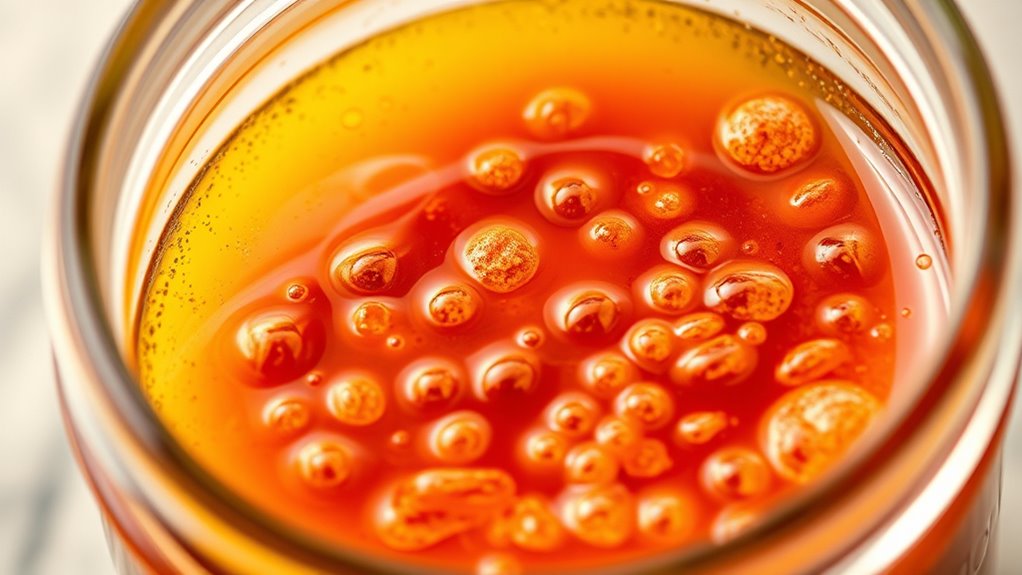
Emulsification is a fundamental technique in cooking that involves blending two liquids that normally don’t mix, such as oil and water, into a stable and uniform mixture. You’ll use emulsifiers like egg yolks or lecithin to achieve this. These compounds have both hydrophilic and lipophilic parts, allowing them to bind with water and oil, forming a barrier that prevents droplets from coalescing. Common examples include mayonnaise, hollandaise sauce, and vinaigrettes. Emulsions can be oil-in-water or water-in-oil, depending on the dispersed phase. Maintaining proper temperature and slow mixing helps prevent the mixture from breaking, ensuring stability. Using the right air purifier maintenance dos and don’ts can help keep your kitchen air clean, reducing dust and allergens that might interfere with food preparation. Proper technique and understanding of the molecular interactions involved can also improve the success of your emulsified sauces. Additionally, understanding essential oils for flavor enhancement can inspire creative variations in your dressings. Recognizing the importance of proper storage can extend the shelf life and quality of your emulsified products. A good grasp of personality traits can assist in troubleshooting and refining your cooking process. Emulsification enhances texture and consistency, making sauces and dressings more appealing and cohesive in your cooking.
Fermentation: Unlocking Flavor and Preserving Food

Just as emulsification stabilizes mixtures in sauces, fermentation harnesses microbial activity to transform raw ingredients into flavorful, preserved foods. Microorganisms like bacteria, yeasts, and molds break down carbohydrates, producing acids, alcohol, and carbon dioxide. These byproducts lower pH, inhibiting harmful bacteria and extending shelf life. Fermentation also develops complex flavors through enzymatic reactions, creating esters, aldehydes, and peptides. Nutritionally, it boosts B vitamins, amino acids, and mineral absorption. Different foods like sauerkraut, yogurt, sourdough, and beverages rely on specific microbes and controlled conditions such as salt, temperature, and oxygen exclusion. Proper fermentation guarantees safety by maintaining a pH below 4.6 and preventing spoilage. Additionally, microbial activity influences the texture and aroma of fermented foods, contributing to their unique characteristics. The presence of proper sanitation practices further helps prevent contamination during fermentation. Implementing temperature control during fermentation ensures consistent results and safety. This process not only preserves food but also enhances umami, texture, and regional culinary identity. Understanding the role of traditional practices can enhance fermentation techniques and outcomes. Regular updates and understanding of investment strategies can help optimize food fermentation practices for safety and quality.
Starch Gelatinization: Transforming Texture in Cooking
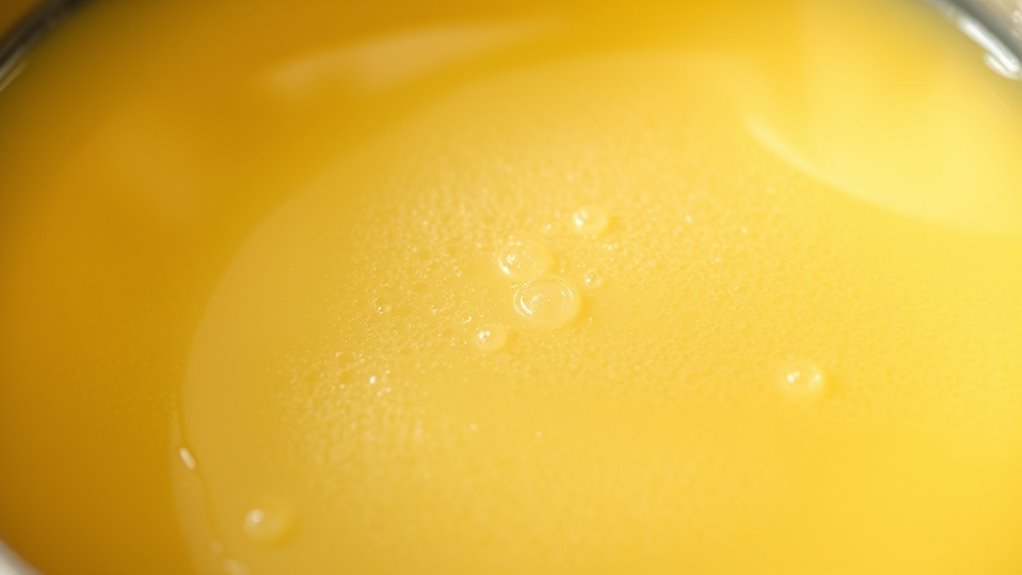
Starch gelatinization is a fundamental process that occurs when starch granules absorb water and heat, transforming raw ingredients into thick, cohesive textures. As you heat starch-rich foods between 60–80°C, the granules swell and lose their crystalline structure, releasing amylose and amylopectin chains. This swelling creates a viscous gel or paste essential for sauces, bread, and pasta. During heating, granules absorb 30–40% water, expanding up to ten times their original size. Once they rupture at higher temperatures, released starch molecules thicken the mixture. Cooling causes amylose retrogradation, which influences final firmness. Factors like water content, starch type, pH, and additives affect gelatinization. Understanding gelatinization is important for controlling the final texture of cooked foods. Proper control of these factors can optimize the gel formation and achieve the desired consistency. Additionally, recognizing how starch properties change during cooking can help bakers and chefs fine-tune their recipes. The temperature control during cooking is critical to ensure proper gelatinization and prevent undesirable textures. Precise temperature management can influence the quality of the end product, making it essential for culinary success.
Chemical Changes During Searing and Roasting
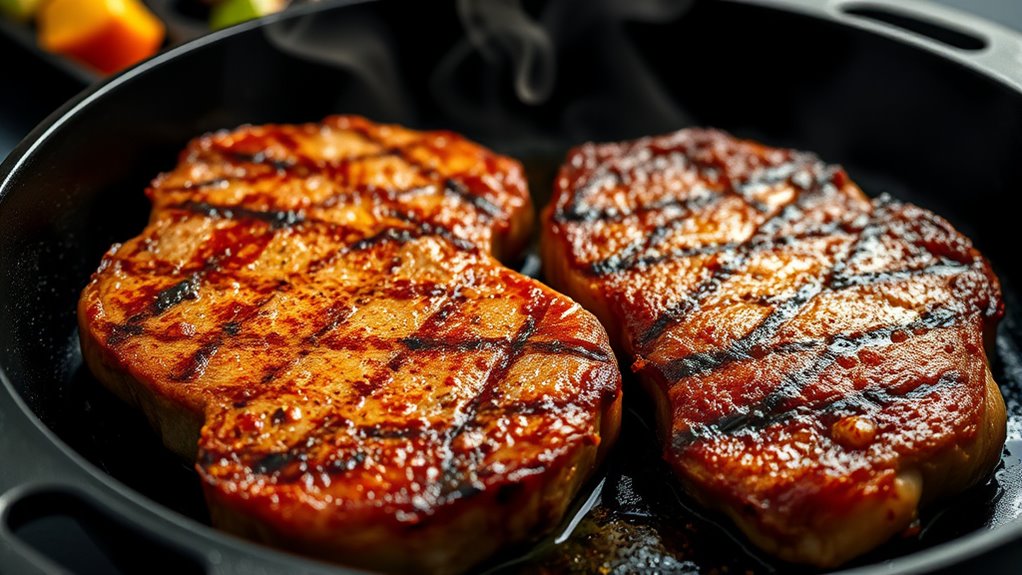
When you sear or roast food at high temperatures, chemical reactions transform its flavor, aroma, and appearance. The Maillard reaction kicks in around 300°F, creating new flavors and browning the surface. This reaction occurs when amino acids combine with reducing sugars, intensifying taste. Caramelization can happen simultaneously, adding subtle sweetness. Maintaining high surface temperatures is essential for proper browning and flavor development, while cookware like cast iron enhances heat retention, boosting the Maillard process. Browning also involves dehydrating the food’s surface, which leads to color changes and fragrant volatile compounds that develop aroma. As moisture evaporates during roasting, flavors concentrate, producing a richer taste. Even heat distribution and proper temperature control guarantee consistent browning, crispy textures, and appealing visual appeal. Engaging in consistent creative practice during cooking can help experiment with different techniques and discover new flavor combinations. Additionally, understanding the chemical changes involved can help optimize cooking methods for better results. Recognizing the importance of heat transfer can further improve the efficiency and quality of your culinary creations, especially when integrating aesthetic home decor concepts like stylish cookware and presentation. Moreover, utilizing knowledge of food science can provide deeper insights into how different ingredients react under various conditions, leading to more predictable and successful outcomes.
The Impact of Acidity and Basicity in Flavor Balance
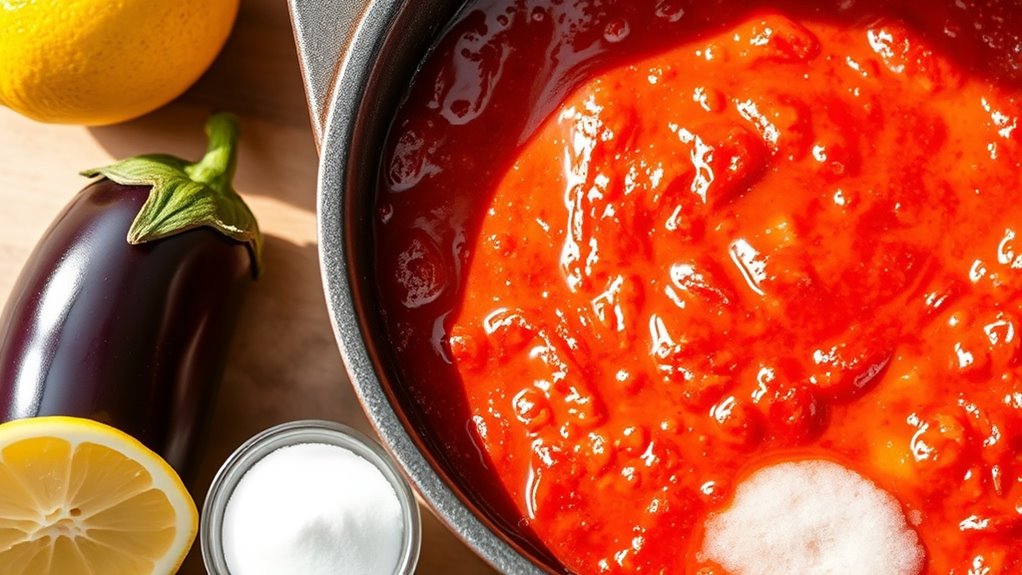
Understanding the impact of acidity and basicity is key to achieving a harmonious flavor balance in your cooking. Acidity, from ingredients like citrus or vinegar, adds a tangy, fresh note that brightens dishes and prevents blandness. Balancing acidity with sweetness or saltiness enhances overall flavor, making dishes more vibrant. Basicity, often from baking soda, reacts with acids to produce carbon dioxide, which helps baked goods rise. Proper pH balance influences texture, tenderizing meats or affecting the rise of baked items. If acidity is too strong, flavors may become overpowering; too little, and dishes can taste flat. Achieving the right balance ensures flavors complement each other, creating a pleasing, well-rounded taste experience in your cooking.
Food Preservation Through Chemical Reactions
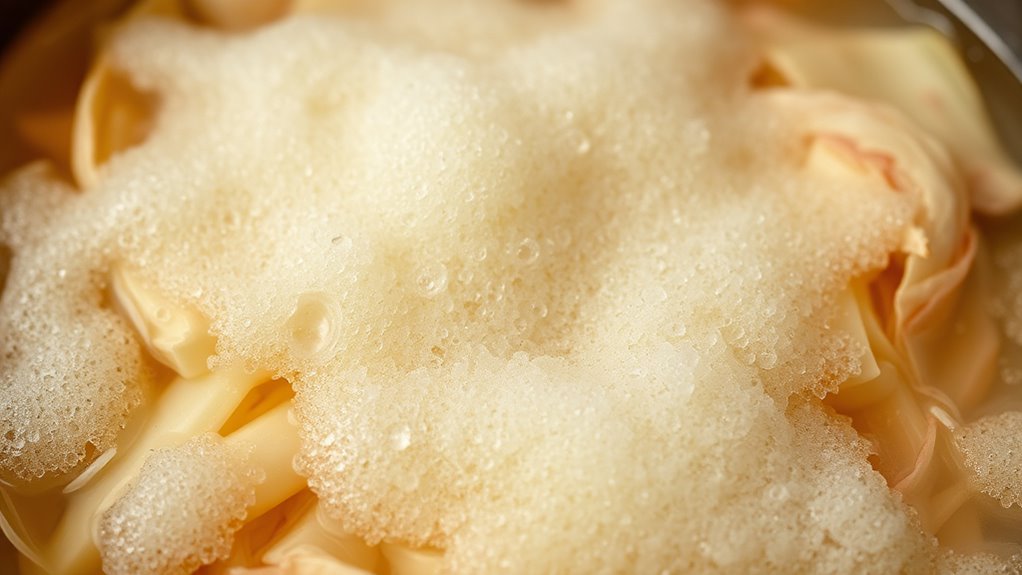
Have you ever wondered how ancient civilizations preserved food without refrigeration? They relied on chemical reactions like fermentation, where microorganisms convert sugars into acids or alcohols, creating hostile environments for bacteria. Salt curing draws moisture out of food through osmosis, inhibiting bacterial growth. Smoking combines dehydration with antimicrobial compounds from wood smoke, helping preserve meat and fish. Pickling uses vinegar to lower pH, preventing microbial proliferation. Sugaring creates a high sugar environment that limits bacterial survival. In modern times, preservatives like benzoates, nitrites, sulphites, sorbates, and propionates are added to extend shelf life. These chemicals inhibit molds, yeasts, and bacteria, ensuring food safety. Enzymatic processes, such as preventing enzymatic browning or controlling protease activity, also help maintain food quality.
Frequently Asked Questions
How Does Temperature Influence Different Chemical Reactions in Cooking?
You see, temperature impacts cooking by controlling how food transforms chemically. When you heat proteins above 60°C, they denature, changing texture. Starches gelatinize at 60–80°C, thickening dishes. Higher temperatures trigger Maillard reactions and caramelization, creating browning and flavor. Too much heat risks burning or creating harmful compounds. By adjusting temperature precisely, you can cultivate desired textures, flavors, and ensure food safety effectively.
Can Chemical Reactions Be Controlled to Improve Food Texture?
Did you know that controlling chemical reactions can considerably improve your food’s texture? You can do this by adjusting heat, moisture, and ingredient choices. For example, precise heat control enhances browning, while managing moisture preserves tenderness. Shortening cooking times or using specific cookware can also influence reactions like gelatinization or caramelization. By mastering these techniques, you guarantee your dishes are perfectly textured every time, making cooking both an art and a science.
Why Do Some Foods Brown Faster Than Others During Cooking?
You notice that some foods brown faster because of their composition and cooking conditions. Foods with higher sugar and protein levels, like onions or bread, brown quicker due to reactions like Maillard or caramelization. Using high heat, dry surfaces, or fats also accelerates browning. Thin slices or porous foods expose more surface area, speeding up the process. Adjusting moisture, pH, and cooking time influences how fast browning occurs.
What Role Do Ph Levels Play in Flavor Development?
You see, pH levels directly influence flavor development. When the environment is acidic (pH 3–5.9), you’ll notice sour tastes and enhanced brightness in sweet foods. Alkaline conditions (pH above 7) promote browning and richer flavors, especially in roasted or baked items. Adjusting pH helps balance bitterness, mask metallic flavors, and control freshness, giving you more control over how flavors evolve and meld in your cooking.
How Do Different Cooking Methods Affect Chemical Changes in Food?
Different cooking methods influence chemical changes in food markedly. When you stir-fry, high heat quickly preserves nutrients and creates crispy textures. Boiling involves water absorption and starch gelatinization, softening foods. Roasting uses dry heat to promote browning through Maillard reactions. Baking and fermentation lead to browning and flavor development, while grilling introduces smoky flavors. Your choice of method impacts texture, flavor, and nutritional content by controlling temperature, moisture, and heat distribution.
Conclusion
Understanding chemical reactions in cooking helps you create better dishes. For example, when you brown meat, the Maillard reaction develops rich flavors and color, elevating your meal. By controlling factors like heat and pH, you can enhance taste and texture. Next time you cook, think about these reactions—you’re not just following recipes, you’re using science to craft delicious, perfectly seasoned, and visually appealing dishes every time.
